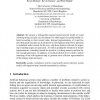Free Online Productivity Tools
i2Speak
i2Symbol
i2OCR
iTex2Img
iWeb2Print
iWeb2Shot
i2Type
iPdf2Split
iPdf2Merge
i2Bopomofo
i2Arabic
i2Style
i2Image
i2PDF
iLatex2Rtf
Sci2ools
ICANN
2010
Springer
2010
Springer
Using Reinforcement Learning to Guide the Development of Self-organised Feature Maps for Visual Orienting
We present a biologically inspired neural network model of visual orienting (using saccadic eye movements) in which targets are preferentially selected according to their reward value. Internal representations of visual features that guide saccades are developed in a self-organised map whose plasticity is modulated under reward. In this way, only those features relevant for acquiring rewarding targets are generated. As well as guiding the formation of feature representations, rewarding stimuli are stored in a working memory and bias future saccade generation. In addition, a reward prediction error is used to initiate retraining of the self-organised map to generate more efficient representations of the features when necessary.
ICANN 2010 | Neural Networks | Reward Prediction Error | Saccadic Eye Movements | Self-organised Map |
Related Content
| Added | 09 Nov 2010 |
| Updated | 09 Nov 2010 |
| Type | Conference |
| Year | 2010 |
| Where | ICANN |
| Authors | Kevin Brohan, Kevin N. Gurney, Piotr Dudek |
Comments (0)

